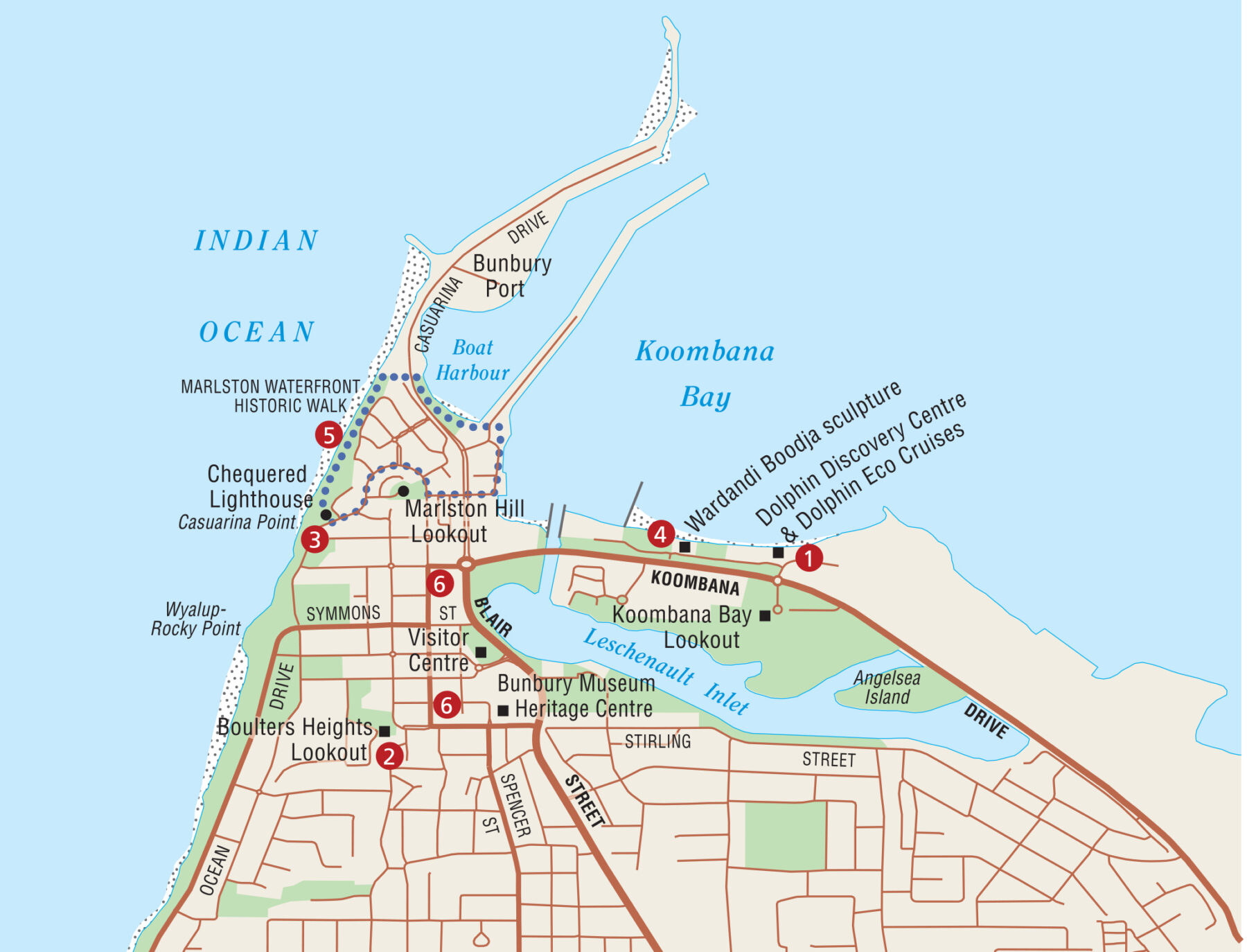A complete guide to Bunbury, WA

Bunbury, established in 1836, became a thriving port later in the century, mainly for the export of wheat from the WA wheatbelt.
With its picturesque Indian Ocean outlook, it developed, at the end of the 19th century, into a popular seaside resort for miners flush with gold from the state’s eastern goldfields. At the time, Bunbury was considered ‘The Brighton of the Colony’.
Today the port concentrates on woodchip and alumina and the city of Bunbury is becoming highly regarded for creative pursuits, supporting regional Australia’s largest collection of street and public art.

Location
Bunbury is located 170km south of Perth, 52km north-east of Busselton and 39km north-west of Donnybrook.
Origin of Name
The city is named after Lt Henry William St Pierre Bunbury (1812–1875), who recommended the area as a suitable place for settlement.
Vistor Information
Bunbury Visitor Centre
Old Railway Station, Haley Street, Bunbury.
Phone: 08 9792 7205 or 1800 286 287
Useful Websites
australiassouthwest.com/destination/bunbury
westernaustralia.com/au/places/bunbury
Image: Bunbury Lighthouse.
(Credit: jamesteohart/shutterstock)
Places of Interest

1. Dolphin Discovery Centre
Located off Koombana Drive, this popular tourist attraction has recently had a $12 million upgrade to be able to showcase “an expanded range of themed fish and coral aquariums and an amazing 360-degree Digital Dolphinarium”.
Its Dolphin Eco Cruises offer 90-minute boat trips on Koombana Bay, allowing visitors to experience the many bottlenose dolphins in the bay. The Swim with the Dolphins tour, available November–April, provides an opportunity to do just that.

2. Boulters Heights Lookout
Located between Wittenoom Street and Haig Crescent, Boulters Heights Lookout was named after A.H. Boulter, who established a rotunda on the site in the late 1920s.
In 1966, to coincide with a visit from the Queen Mother, the local council built a 26m waterfall, the remnants of which still exist.
The lookout provides panoramic views across Leschenault Inlet.
3. Chequered Lighthouse
The current Bunbury Lighthouse, off Marlston Drive and overlooking Casuarina Point, is the fifth lighthouse to be built to guide ships into Koombana Bay.
The original lighthouse, a wooden keg with a storm lantern, was replaced first by a square wooden lighthouse in 1870, then a temporary tower in 1901, followed by a cast iron beacon in 1903.
The current chequered lighthouse was built in 1971. Its height is now 37m above sea level and it’s visible from 20km in clear weather.
4. Wardandi Boodja sculpture
Located on Koombana Bay foreshore, the Wardandi Boodja sculpture is a 5.5m high steel bust of a Noongar man.
Designed to represent all Noongar families, it was commissioned by the City of Bunbury and funded under the state government’s Royalty for Regions policy.
The huge sculpture is the work of local artists Alex and Nicole Mickle of Safehaven Studios and a design engineer, Mike Kimble.

5. Marlston Waterfront Historic Walk
This pleasant walk along the promenade on the Marlston Waterfront has a number of interesting signs. These provide details of Bunbury’s history, including stories of: the 29 ships wrecked in Koombana Bay (also known as Shipwreck Bay); the convicts who constructed the first jetty using local jarrah; the breakwater off Casuarina Point, which was designed by the great C.Y. O’Connor, who built the famous pipeline that transported water to Kalgoorlie, and a bust of Nicolas Baudin, the French explorer who sailed down the WA coast in 1800.
6. Bunbury’s street art and public sculptures
There are two maps – ReDiscover Murals and Outside the Box – that provide detailed information to allow visitors to explore the 31 murals and artworks dotted around the centre of the city.

History
Before Europeans, the area
was home to the Wardandi
Noongar people.
An 1803 French expedition led by Captain Louis de Freycinet (pictured right) explored the Bunbury coastline.
By 1830 a military presence had been established in the area in response to conflicts with local Aboriginal groups.
In 1836 Lt Henry William St Pierre Bunbury travelled south through the area while on an
expedition from Pinjarra, north-east of what is now Bunbury, to the Vasse River.
The first European settlers, John Scott and his family, arrived in 1838.
By 1841 almost 400 Europeans were living in the new town of Bunbury.
St Marks Church, WA’s second-oldest Anglican church, was built at Picton (now Wollaston) in 1842.
By 1893 Bunbury was connected to Perth by rail, having become a major export port for karri and jarrah cut and milled in the hinterland.
In the 1890s the town became an important seaside resort.
Bunbury became a city on 8 October 1979.
In 2005–06 Bunbury was Australia’s fastest growing city.
Image credit: Wikipedia


